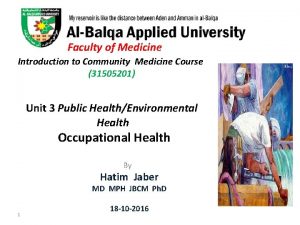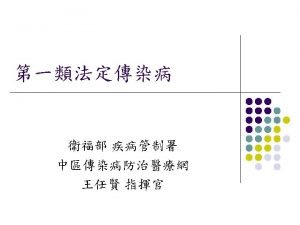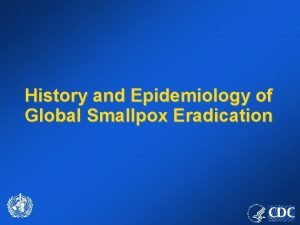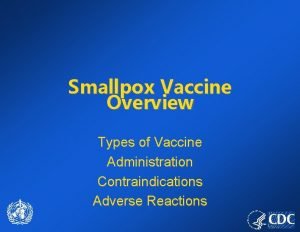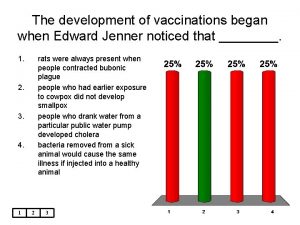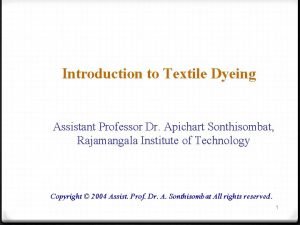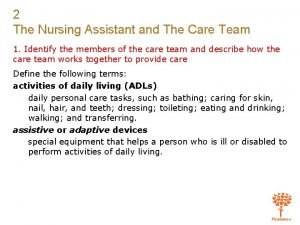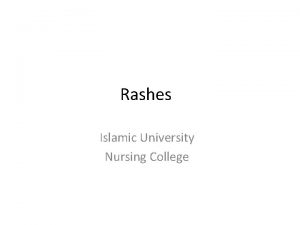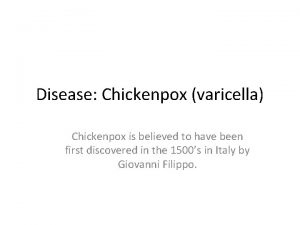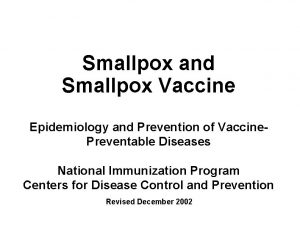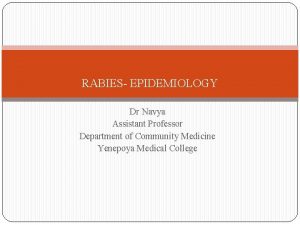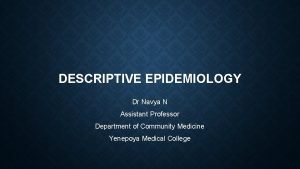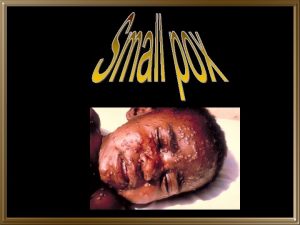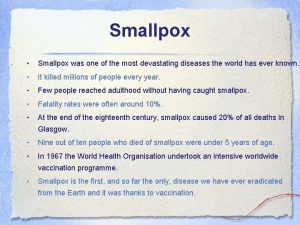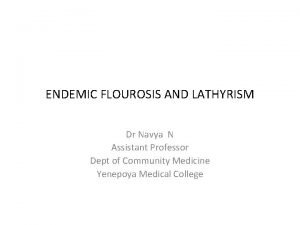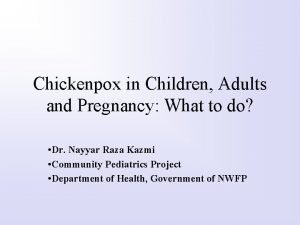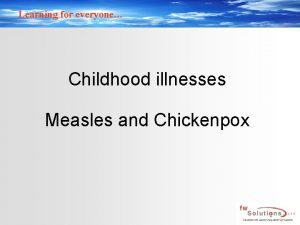SMALLPOX AND CHICKENPOX Dr Navya N Assistant professor






























- Slides: 30


SMALLPOX AND CHICKENPOX Dr Navya N Assistant professor Department of community medicine Yenepoya medical college

SPECIFIC LEARNING OBJECTIVES ■ At the end of the class the students should be able to 1. Describe about eradication of smallpox 2. Explain the epidemiological determinants of chickenpox 3. Differentiate between the clinical features of chickenpox and smallpox 4. Describe about the preventive measures of chickenpox

SMALLPOX ■ Acute infectious disease- Variola Virus ■ Clinically characterized- sudden onset of fever, headache, backache, vomiting sometimes convulsions- children. ■ Third day of fever- typical rash appears- centrifugal in distribution ■ Successive stages- macule papule, vesicle, pustule, and scab with subsequent scarring.

HISTORY ■ 1967 - endemic in 33 countries ■ WHO – vast international campaign – 1967 - 1979 – eradication ■ Last indigenous case in India- 17 th may 1975 – Bihar ■ Last known case in India ( Importation –Bangladesh) – 24 th may 1975 ■ April 1977 – India declared small pox free ■ Last case in the world – 26 october 1977 ■ Laboratory accident – 1978 ■ WHO Eradication of Small pox – 8 th May 1980 ■ Vaccination – discontinued ■ WHO – reserve stock- vaccine and vaccination needles – emergency -200 million people

CASE DEFINITION – IHR ( 2005) ■ Member states – IHR (2005) – notify WHO immediately- any confirmed case Confirmed Case : ■ Individual- any age- acute fever ( >= 38. 3 o C / 101 o F) , malaise, severe prostration with headache, backache- 2 -4 days before- rash AND ■ Maculopapular rash – starting on face and forearms – trunk and legs ■ Within 48 hrs – deep seated, firm or hard , round well circumscribed vesicles – later pustules – umblicated or confluent AND ■ All lesions – same stage of development AND ■ No alternative diagnosis AND ■ Laboratory confirmation


EPIDEMIOLOGICAL FACTORS- ERADICATION ■ No known animal reservoir ■ No long term carrier of virus ■ Life long immunity- post recovery ■ Detection of cases – easy ■ Subclinical infection – did not transmit disease ■ Animal reservoir- absent ■ Vaccine – highly effective, easily administered , heat stable, long term protection ■ International cooperation

Small pox Vaccine

■ Eradication – everted – 2 million deaths, - few hundred thousand cases – blindness 10 -15 million cases of disease / year- prevented ■ Smallpox virus- not completely destroyed stocks – govt research centres – US and Russian Federation

CHICKENPOX ■ Chickenpox/ varicella- acute, highly infectious disease- varicella-zoster (V -Z) virus. ■ Characterized- vesicular rash- accompanied by fever and malaise ■ Epidemic and endemic forms ■ Chickenpox and herpes zoster- different host responses- same aetiological agent. ■ Inoculation of zoster vesicle fluid into children produces chickenpox ■ Children- recovered from zoster virus related infection- resistant to varicella

PROBLEM STATEMENT ■ Global annual chickenpox disease burden – 4. 2 million severe complications 4, 200 deaths ■ Pre vaccine era – case fatality rate - developed countries – 3/lac cases compared to 1 -3/ 1000 cases for measles ■ Factors – influence – severity and outcome : 1. proportion of cases- infants, pregnant women, other adults , 2. prevalence – immunocompromised conditions , 3. extent of access to care and appropriate treatment INDIA : ■ 2013 - 28, 090 cases with 61 deaths ■ Case fatality rate – 0. 21% ■ Highest cases- Kerala

EPIDEMIOLOGICAL DETERMINANTS – AGENT FACTORS (a) AGENT : V-Z virus is also called "Human (alpha) herpes virus 3". ■ Primary infection causes chickenpox. ■ Recovery from primary infection- followed- establishment- latent infection- cranial nerves sensory ganglia and spinal dorsal root ganglia- without clinical manifestations. ■ Cell-mediated immunity wanes with age or following immuno-suppressive therapyvirus may reactivate- herpes zoster- 10 -30%. ■ Herpes zoster - Painful. vesicular, pustular eruption in the distribution of one or more sensory nerve roots.

EPIDEMIOLOGICAL DETERMINANTS – AGENT FACTORS (b) SOURCE OF INFECTION: case of chickenpox, rarely – patient with herpes zoster ■ Virus- oropharyngeal secretions and lesions- skin and mucosa. ■ Virus- readily isolated- vesicular fluid during the first 3 days of illness. ■ Scabs- not infective

EPIDEMIOLOGICAL DETERMINANTS – AGENT FACTORS (c) INFECTIVITY: ■ Period of communicability-1 to 2 days before appearance of rash, 4 to 5 days thereafter ■ Virus tends to die out before pustular stage ■ Patient ceases to be infectious- lesions have crusted (d) SECONDARY ATTACK RATE: Secondary attack rate- household contacts- 90%

EPIDEMIOLOGICAL DETERMINANTS – HOST FACTORS (a) AGE : Primarily- children under 10 years of age. ■ Disease- severe- normal adults. (b) IMMUNITY : One attack- durable immunity; second attacks- rare. ■ Maternal antibody protects- infant- first few months of life. ■ No age- exempt in- absence of immunity. ■ Ig. G antibodies persist for life and their presence- protection against varicella. ■ Cell-mediated immunity- important in recovery from V-Z infections and protection against- reactivation (c) PREGNANCY : Presents a risk - foetus and the neonate

EPIDEMIOLOGICAL DETERMINANTS – Environmental factors : seasonal trend in India- mostly- first six months of the year. ■ Over-crowding favours- transmission. Transmission : person to person- droplet infection and by droplet nuclei. ■ Most patients- infected- "face-to-face" (personal) contact. ■ Portal of entry- respiratory tract. ■ Virus extremely labile- unlikely- fomites ■ Contact infection- individual- herpes zoster- index case. ■ Virus - cross the placental barrier and infect the foetus- congenital varicella.

Clinical features ■ Incubation period- 14 to 16 days, ■ Clinical spectrum of chickenpox- mild illness- few scattered lesions- severe febrile illnesswidespread rash. ■ Inapparent infection- no more than 5 per cent- susceptible children ■ Majority- disease- mild and typical ■ Two stages : 1. Pre eruptive stage 2. Eruptive stage

Clinical features -PRE-ERUPTIVE STAGE : ■ Onset- sudden ■ Mild- moderate fever ■ Pain in the back, ■ Shivering and malaise. ■ This stage- very brief- lasting about 24 hours. ■ In adults- prodromal- more severe- last for 2 -3 days before rash

Clinical features -ERUPTIVE STAGE : ■ Children- rash- often first sign- comes- day the fever starts. ■ Distinctive features- rash are : 1. Distribution : symmetrical. ■ First appears- trunk- abundant, and then comes on the face, arms and legs- less abundant. ■ Mucosal surfaces (e. g. , buccal, pharyngeal)- generally involved. ■ Axilla- affected, but palms and soles- not usually affected. ■ Density of eruption diminishes centrifugally.

Clinical features -ERUPTIVE STAGE 2. Rapid evolution : ■ Rash advances quickly- macule papule vesicle scab. ■ First to attract attention- vesicles filled with clear fluid- "dew-drops" on the skin. ■ Superficial in site- easily ruptured walls and surrounded- area of inflammation. ■ Not umbilicated. ■ Vesicles- form crusts without going through- pustular stage. ■ Scabbing begins 4 - 7 days after- rash appears.


Clinical features -ERUPTIVE STAGE 3. Pleomorphism : characteristic feature- all stages of rash(papules, vesicles and crusts)seen simultaneously at one time- same area. ■ Rash appears- successive crops- 4 to 5 days- same area. 4. Fever: Not high, but - exacerbations with each fresh crop of eruption.


COMPLICATIONS ■ Mortality- < 1%- uncomplicated cases. ■ Complications- immunosuppressed/ normal children and adults. ■ Haemorrhages (varicella haemorrhagical), ■ Pneumonia - neonates, adults and immuno-compromised patients- varicella related deaths ■ Encephalitis ■ Acute cerebeller ataxia ■ Reye's syndrome (acute encephalopathy associated with fatty degeneration- viscera especially liver)

COMPLICATIONS ■ Maternal varicella- foetal wastage and birth defect, low birth weight, cataract, microphthalmia, chorioretinitis, deafness and cerebro-cortical atrophy. ■ Varicella- mother within 5 days after delivery, the newborn risk-disseminated disease ■ Secondary bacterial infections- group A beta haemolytic streptococci and staphylococcus aureus ■ Cellulitis, erysipelas, epiglottitis, osteomyelitis, scarlet fever, rarely meningitis. ■ Pitted scars- frequent sequelae. ■ lmmunocompromised patients- Disseminated intravascular coagulation ■ Children with leukaemia- prone to severe disseminated varicella-zoster virus disease

LABORATORY DIAGNOSIS ■ Laboratory diagnosis is rarely required, clinical signs- usually clear-cut. ■ The most rapid and sensitive- vesicle fluid- electronic microscope. CONTROL : ■ Notifications, ■ Isolation of cases - 6 days after onset of rash ■ Disinfection of articles soiled by nose and throat discharges ■ Several antiviral compounds- effective therapy ■ Acyclovir, valacylovir, famiciclovir and foscarnet


SUMMARY ■ WHO eradication of smallpox – 8 th may 1980 ■ Small pox vaccine – discontinued ■ Chicken pox – varicella zoster virus ■ Highly infectious – Respiratory route ■ Characteristic features – rashes abundant in trunk and back, rapid evolution, pleomorphism ■ Complications of chickenpox – most commonly – adults and immunocompromised ■ Pneumonia – most common complication leading to varicella related deaths ■ Vaccination

THANK YOU
 Smallpox vs chickenpox
Smallpox vs chickenpox Electroplating station
Electroplating station Diff between measles and chickenpox
Diff between measles and chickenpox Chickenpox vaccine schedule
Chickenpox vaccine schedule Chickenpox pathophysiology
Chickenpox pathophysiology Chickenpox
Chickenpox Promotion from associate professor to professor
Promotion from associate professor to professor Fok ping kwan
Fok ping kwan Smallpox
Smallpox Menstruosity
Menstruosity Smallpox vaccine industrial revolution description
Smallpox vaccine industrial revolution description About how many cherokees died of smallpox in 1745
About how many cherokees died of smallpox in 1745 Smallpox endemic
Smallpox endemic Smallpox definition ap world history
Smallpox definition ap world history Smallpox vaccine needle
Smallpox vaccine needle A vaccination for smallpox was developed in 1796 by ____
A vaccination for smallpox was developed in 1796 by ____ What are the duties of assistant scorer?
What are the duties of assistant scorer? Good morning madam. may i help you
Good morning madam. may i help you Did you go shopping
Did you go shopping Printing and dyeing assistant
Printing and dyeing assistant Ethical and legal issues affecting the nursing assistant
Ethical and legal issues affecting the nursing assistant The nursing assistant and the care team
The nursing assistant and the care team Chapter 2 foundations of resident care
Chapter 2 foundations of resident care Professor's beloved equation
Professor's beloved equation The sign makers assistant
The sign makers assistant As a laboratory assistant you measure chemicals
As a laboratory assistant you measure chemicals Chapter 2 the professional dental assistant
Chapter 2 the professional dental assistant Fujitsu home assistant
Fujitsu home assistant Rop santa cruz
Rop santa cruz Mia irwan
Mia irwan Cisco sbcs
Cisco sbcs



